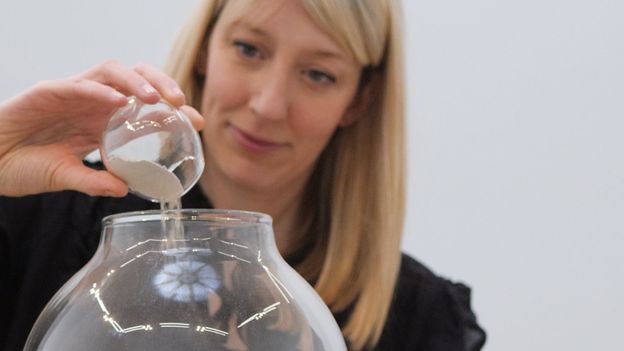In 1788, three men set off to search a stretch of coast in eastern Scotland, looking for a very special outcrop of rocks. It would reveal that Earth was far, far older than anybody thought.
Leading the party was James Hutton, one of the first geologists. His goal was to show his peers an “unconformity” – two juxtaposing rock layers, separated by a sharp line.
If you stumbled on one, you might not recognise its significance, but it proved that aeons of “deep time” had passed before humans emerged on Earth. There was no other way to explain these features.
Hutton’s unconformity (yellow) at Siccar Point, which he reasoned must have taken millions of years to form (Credit: Adam Proctor)
For centuries, the Biblical account of time had been dominant in Europe. By one analysis of the generations in the Old Testament, conducted by an archbishop in 1650, the Earth must have been created in 4004BC.
Hutton, however, would transform that view.
His companions to Siccar Point, east Scotland, in 1788 were astonished. As one of them wrote afterwards: “The mind seemed to grow giddy by looking so far back into the abyss of time. And while we listened with earnestness and admiration to the philosopher who was now unfolding to us the order and series of these wonderful events, we became sensible how much further reason may sometimes go than imagination may venture to follow.”
The insight would be one of geology’s most transformational contributions to human thought, allowing us to “burst the limits of time”, as one eminent scientist later put it. Time, according to Hutton, had “no vestige of a beginning, no prospect of an end”.
Looking down at Hutton’s Unconformity, on an “Anthropocene coast” (Credit: Adam Proctor)
The discovery of deep time would change how we see the world. Not only did it rewrite the Biblical account of time, it would provide the canvas for the theory of evolution. Later, it would help astronomers to show that the Earth itself was relatively young compared with the age of Universe.
For the past few years, I have been writing and researching about how to take a longer view. To help me understand the mind-expanding scope of deep time, I recently set out to make three films for the BBC about its discovery and implications – starting with a trip to Hutton’s unconformity.
Looking back to the past, how did Hutton’s discovery change the world? How might we make sense of deep time’s daunting scale in the present? And how should we think about the deep future?
Watch all three as a playlist on BBC Reel or further down this page.
In the first of the films, I traced the steps of Hutton and his companions to the unconformity at Siccar Point.
In the 18th Century, the three men used a boat to get there, but I chose to hike there with David Farrier, a professor of literature and the environment at the University of Edinburgh. As the author of the book Footprints, which is about the “future fossils” we are leaving behind in the Anthropocene, he was the ideal companion. Why? As we’d discover, this particular stretch of coastline is now notable for more than its natural features: it also hosts a nuclear power station and a carbon-intensive cement works, whose own legacies will continue long into the future.
Later, I also met musician Karine Polwart, who – during the Covid-19 pandemic – was inspired to record a song about Hutton’s discovery at Siccar Point.
WATCH:
In the second film, I wanted to explore how we might make sense of the awe-inspiring scale of deep time today – and crucially, not just with the lens of science alone.
When I reflect on how short my own lifespan is within the million-year chronologies of the Earth, it can feel pretty daunting. From the planet’s perspective, our lives are momentary flashes of light on the surface of a lake; briefly bright, but quickly gone. Thinking about deep time can therefore be a sublime experience: astonishing, but tinged with the awareness of your own mortality.
One person who has spent a career thinking about deep time is the artist Katie Paterson. Through her artworks, she makes long-term timescales more accessible, more comprehensible, more human.
In the film, I visited two of her projects: the Future Library in Norway, which contains books that can’t be read until 2114, and Requiem, which tells the story of the Earth and humanity through 34 vials of dust, from pre-solar grains to a crushed tree branch from the site of the Hiroshima atomic bomb.
Paterson’s work helps to make the long view of deep time a little bit easier to comprehend – as well as providing clarity and urgency about the role that our generation is playing within it.
WATCH:
Finally, in the third film, I reflected on our personal, generational connections across long-term time: not just to the past, but the deep future too.
When I daydream about the life that could lie ahead for my daughter Grace, I realise that she stands a pretty good chance of seeing the 22nd Century. Born in 2013, she would be 86 years old when 2100 arrives. If she has grandchildren or great-grandchildren, they might even reach the next century after that.
Through our family ties, we are far closer to seemingly distant dates in time than first appears – and we have a surprising amount in common with one another in terms of our ancestry too. As the film explores, you don’t even need to have children to figure in this deep time narrative, and your actions today will reach far further across time than you might realise.
WATCH:
Making these films, I realised that deep time needn’t be an impersonal, cold concept, and that there are benefits to be found by embracing a million-year view.
The writer John McPhee, who popularised the term in the 1980s, argued – perhaps pessimistically – that human beings may not be capable of grasping the concept of deep time to its full extent. “The human consciousness may have begun to leap and boil some sunny day in the Pleistocene, but the race by and large has retained the essence of its animal sense of time,” he wrote in his influential book Basin and Range. “People think in five generations – two ahead, two behind – with heavy concentration on the one in the middle. Possibly that is tragic, and possibly there is no choice.”
McPhee suggested that the units of years, the common currency of humanity’s temporal understanding, become ever-less useful and tractable once time becomes very big. “Numbers do not seem to work well with regard to deep time. Any number above a couple of thousand years – 50,000, 50 million – will with nearly equal effect awe the imagination to the point of paralysis,” he wrote.
However, while it is true that million-year chronologies may be beyond our direct sensory faculties, that doesn’t mean we cannot try to extend the mind over thousands, millions or even billions of years. And there could be upsides to doing so: a deep-time view can provide the kind of perspective that we need within the upheaval of the Anthropocene.
As Paterson told me when we met in Edinburgh: “It’s a mind-bending concept thinking about things that happened millions, billions of years into the past. And I can understand that some people might find that pretty difficult. Oddly, I never have. I’ve always just been absolutely delighted by this idea that we’ve got the capacity to know and understand or imagine what’s come before us. I find it really inspiring and eye-opening and moving, and it gives me a kind of rootedness.”
*Richard Fisher is the author of The Long View: Why We Need to Transform How the World Sees Time, and a senior journalist for BBC Future. Twitter: @rifish
The Deep Time films were filmed, edited and produced by Adam Proctor at Fortsunlight.
—
Join one million Future fans by liking us on Facebook, or follow us on Twitter or Instagram.
If you liked this story, sign up for the weekly bbc.com features newsletter, called “The Essential List” – a handpicked selection of stories from BBC Future, Culture, Worklife, Travel and Reel delivered to your inbox every Friday.





